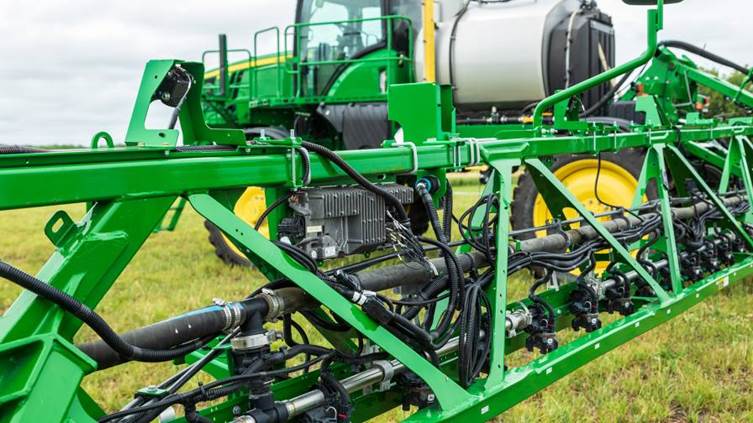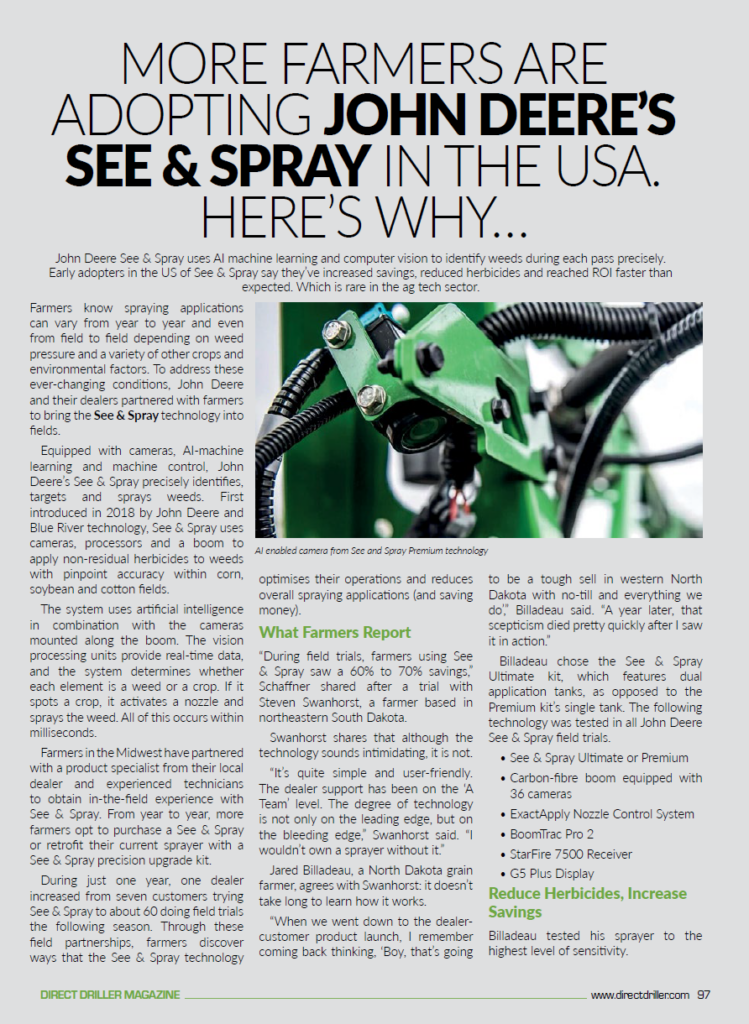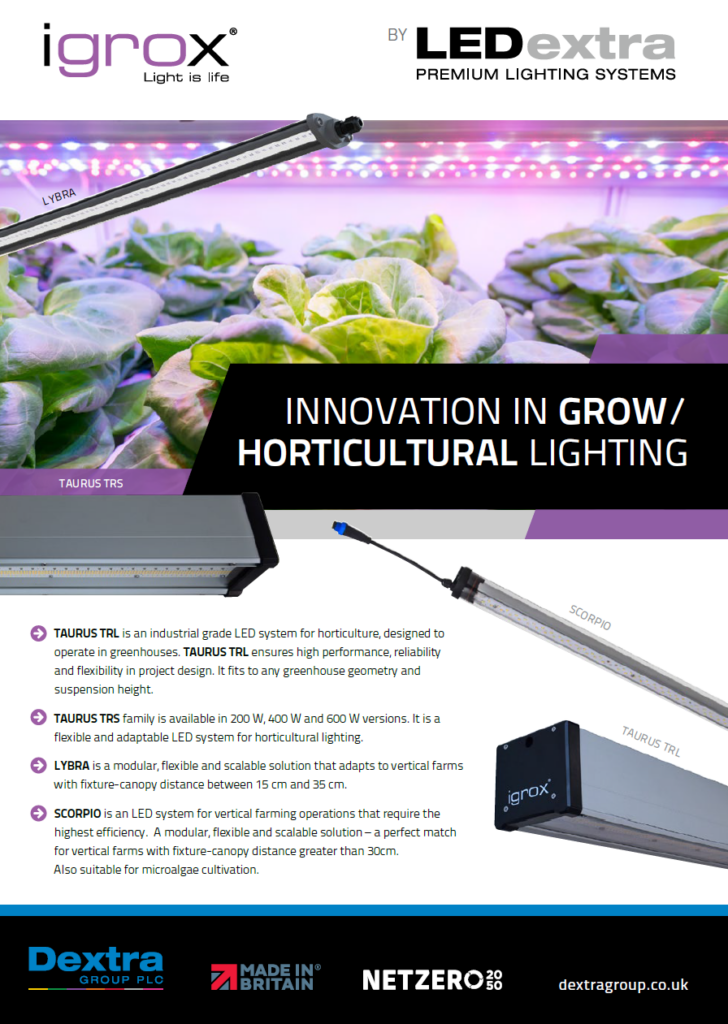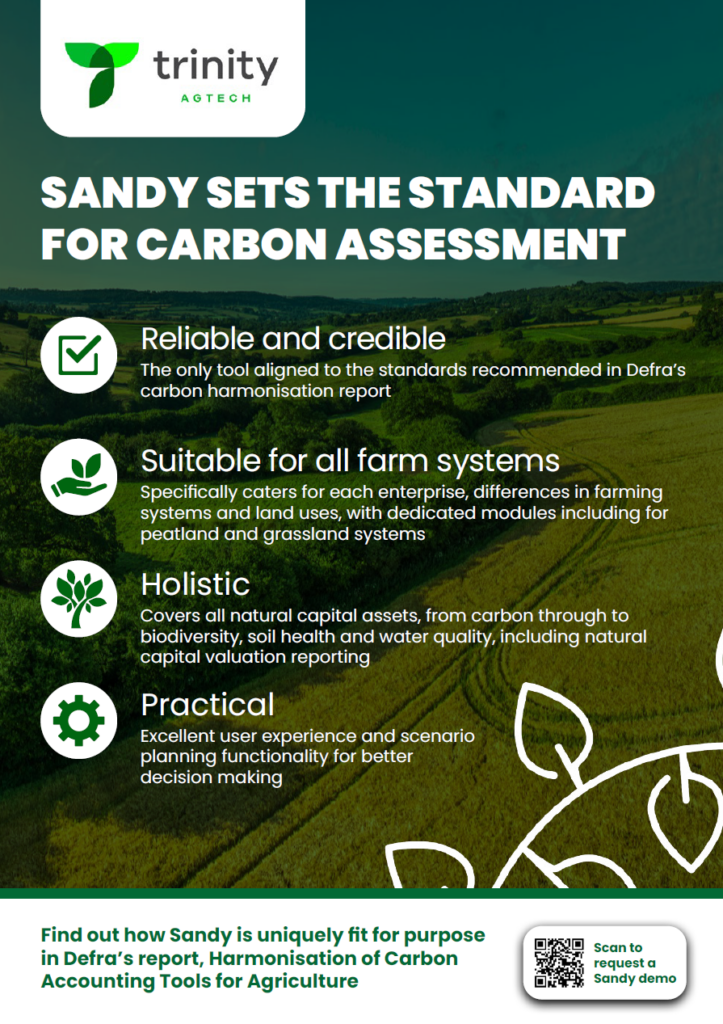John Deere See & Spray uses AI machine learning and computer vision to identify weeds during each pass precisely. Early adopters in the US of See & Spray say they’ve increased savings, reduced herbicides and reached ROI faster than expected. Which is rare in the ag tech sector.
Farmers know spraying applications can vary from year to year and even from field to field depending on weed pressure and a variety of other crops and environmental factors. To address these ever-changing conditions, John Deere and their dealers partnered with farmers to bring the See & Spray technology into fields.
Equipped with cameras, AI-machine learning and machine control, John Deere’s See & Spray precisely identifies, targets and sprays weeds. First introduced in 2018 by John Deere and Blue River technology, See & Spray uses cameras, processors and a boom to apply non-residual herbicides to weeds with pinpoint accuracy within corn, soybean and cotton fields.

AI enabled camera from See and Spray Premium technology
The system uses artificial intelligence in combination with the cameras mounted along the boom. The vision processing units provide real-time data, and the system determines whether each element is a weed or a crop. If it spots a crop, it activates a nozzle and sprays the weed. All of this occurs within milliseconds.
Farmers in the Midwest have partnered with a product specialist from their local dealer and experienced technicians to obtain in-the-field experience with See & Spray. From year to year, more farmers opt to purchase a See & Spray or retrofit their current sprayer with a See & Spray precision upgrade kit.
During just one year, one dealer increased from seven customers trying See & Spray to about 60 doing field trials the following season. Through these field partnerships, farmers discover ways that the See & Spray technology optimises their operations and reduces overall spraying applications (and saving money).
What Farmers Report
“During field trials, farmers using See & Spray saw a 60% to 70% savings,” Schaffner shared after a trial with Steven Swanhorst, a farmer based in northeastern South Dakota.
Swanhorst shares that although the technology sounds intimidating, it is not.
“It’s quite simple and user-friendly. The dealer support has been on the ‘A Team’ level. The degree of technology is not only on the leading edge, but on the bleeding edge,” Swanhorst said. “I wouldn’t own a sprayer without it.”
Jared Billadeau, a North Dakota grain farmer, agrees with Swanhorst: it doesn’t take long to learn how it works.
“When we went down to the dealer-customer product launch, I remember coming back thinking, ‘Boy, that’s going to be a tough sell in western North Dakota with no-till and everything we do’,” Billadeau said. “A year later, that scepticism died pretty quickly after I saw it in action.”
Billadeau chose the See & Spray Ultimate kit, which features dual application tanks, as opposed to the Premium kit’s single tank. The following technology was tested in all John Deere See & Spray field trials.
- See & Spray Ultimate or Premium
- Carbon-fibre boom equipped with 36 cameras
- ExactApply Nozzle Control System
- BoomTrac Pro 2
- StarFire 7500 Receiver
- G5 Plus Display
Reduce Herbicides, Increase Savings
Billadeau tested his sprayer to the highest level of sensitivity.
“I might’ve been a little more sceptical on this, so I headed to the most aggressive settings you could, spraying the most it could,” he said. “We were at about a 50-50 savings.”
As Biladeau became more familiar with the machine, he adjusted the settings and decreased the number of acres sprayed, saving about 60% of the spraying application.
“The default settings alone are going to save you a lot and there’s not going to be any skips out there, because the cameras on the sprayer are precise,” he said.
Billadeau shares that emptying See & Spray’s tank takes a long time, reducing the dependence on another operator running a water trailer for refills. Billadeau was able to save time and minimize application volume. See & Spray reduces stress on crops. The ability to test different nozzles and sprayer calibrations for even coverage also helped Billadeau to reduce overall stress on crops.
“I discovered that different sprayer nozzles may change your application,” he said. “Talk to your dealer about the different options and test it out.”
Machine Learning Improves Year Over Year
When farmers use John Deere See & Spray, they automate the spraying data upload to the John Deere Operations Centre. This data can be used to create weed pressure maps, which provide a valuable picture of a field’s behaviour over time.
“I learned that your fields are very predictable,” Billadeau said. “After you look at a See & Spray coverage map, you can see a tree row removed 10 years ago, or the perimeters of your fields are heavier in weed density. All this info helps me to make informed decisions about spraying.”
Based on previous seasons’ spraying application data, John Deere See & Spray’s machine learning processors and cameras can better detect weeds in areas where they may have become resistant due to heavier chemical use.
Reach ROI Faster Than Other Equipment
Pudwill, from a dealer in North Dakota who works with farmers each year to ensure their ag technology solutions are set up for their fields’ conditions, said that in his experience, most farmers who purchase the See & Spray report reaching a return on their initial investment in about a year and a half.
“John Deere’s See & Spray is in an investment, but with the amount of time, knowledge I’ve gained from it seems to be well worth the value,” Swanhorst said.
Schaffner agrees it’s possible for most farmers in the Dakotas to keep their “payback period” as short as possible through the herbicide savings they experience, and additional early adopter programs offered by John Deere or trusted equipment dealers.
“John Deere changed its See & Spray license to a use-based model within the first year, which set up the solution to achieve better application savings,” Pudwill said. “For example, if you cover 4000 acres but only apply on 1500 acres, you will pay the subscription fee for just the 1,500 acres you sprayed.”
Billadeau said that, with its use-based licensing model, using See & Spray for every acre is an easy decision.
“My John Deere See & Spray allows me to have effective weed control each year, especially in crops where we are starting to see some weed pressure or resistance to herbicide.”
See and Spray

See & Spray Premium utilizes advanced stability by John Deere BoomTrac Pro 2.0.
In 2023, John Deere introduced a See & Spray Premium performance upgrade kit for John Deere self-propelled sprayers, the next addition in the See & Spray lineup. The kit uses a vision system powered by artificial intelligence that can help farmers gain cost efficiency and combat herbicide resistance with precise application by only spraying the weeds and not the entire field.
With See & Spray Premium farmers gain access to advanced See & Spray technology that targets weeds with non-residual herbicides in corn, cotton, soybeans and fallow fields.
In addition, they can still use their sprayer all season long to make broadcast applications at standard operating speeds.
As the sprayer moves through the field, See & Spray Premium utilizes advanced stability provided by John Deere BoomTrac Pro 2.0. This technology stabilizes the sprayer boom as cameras mounted to the boom capture clear images of the field. Within milliseconds, a machine learning model uses multiple images captured by the cameras to differentiate weed from crop. Once a weed is detected, a command is sent to the John Deere ExactApply nozzle to spray it. In addition, See & Spray Premium can be used to generate a weed pressure map for the field that was sprayed in the John Deere Operations Center.
See & Spray Premium provides farmers who are happy with their current sprayer, or who recently traded into a sprayer, a way to take advantage of the latest John Deere technology that can help them reduce chemical use and lower their input costs.




